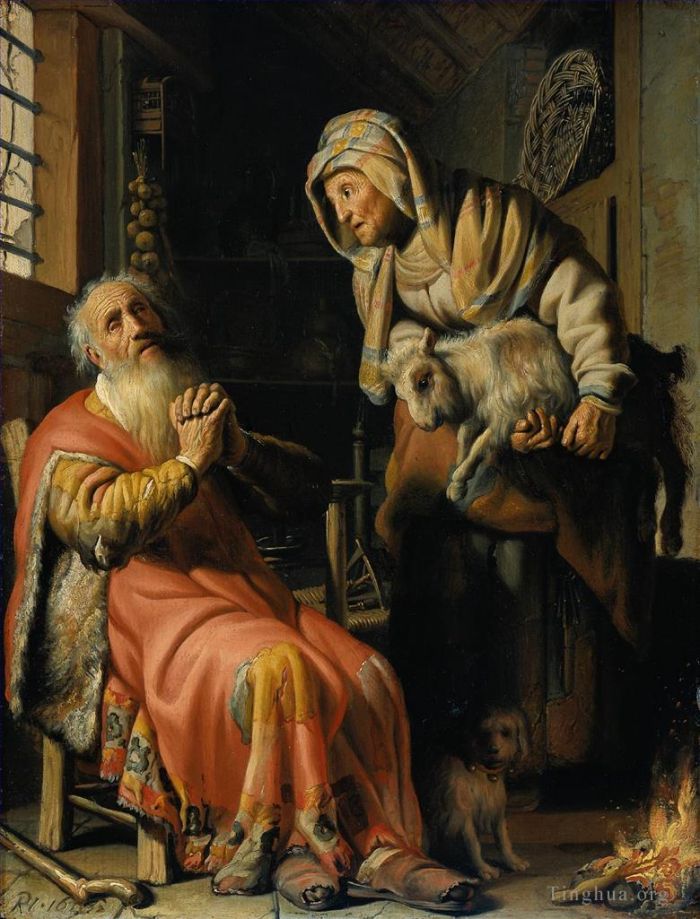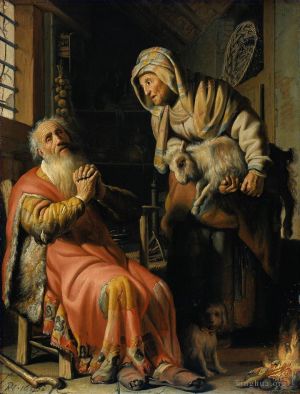Tobit and Anna with the Kid
Rembrandt
- Price: Price on Request
- Art Type: Oil Painting
- Size:
- English Comments: 0
- International Comments: 0
- Creating Date:
- Introduction and Works of Rembrandt >>
Work Overview
- Tobit and Anna with the Kid
REMBRANDT Harmenszoon van Rijn
1626
Oil on panel
h 39.5cm × w 30cm
Rijksmuseum, Amsterdam
This painting dates from shortly after Rembrandt had set up as an independent artist in Leiden in 1625.
The subject is taken from the Apocryphal Book of Tobit (Chapter II, vv, 11-14). Tobit was a wealthy, God-fearing Jew, strict in his observance of the Mosaic law, who had lost all his money and been blinded in an accident. To keep them from starving, his wife Anna took in sewing and washing. One day, hearing the bleating of a kid which Anna had been given to supplement her earnings, Tobit falsely accuses her of having stolen it. In return, she upbraids him for his self-righteousness which has brought them to their present plight (this is the scene represented in the picture). Later, however, the couple's fortunes are restored by their son, Tobias, who goes to find the money his father has lost and to marry a rich wife. On the way he meets the Angel Raphael, who instructs him when they come to a river to catch a large fish, the entrails of which are afterwards applied to Tobit's eyes to cure his blindness.
In this work Rembrandt depicts the psychological tension between the two protagonists. The mood of the blind old Tobit suddenly becomes one of suspicion and despair when he wonders how his wife, Anna, has managed to lay hands on a kid. She in turn is baffled by his mistrust.
The space depicted is confined but packed with domestic detail: onions hanging up by the window, a basket on the wall, cooking utensils on the shelves, part of Anna's sewing apparatus glimpsed between the two figures, and, in the foreground, Tobit's stick, his dog and a modest fire.
Such meticulously painted still-life detail had been a characteristic of Netherlandish art since the fifteenth century. However, in contrast to so many examples of its use up to and including the seventeenth century, it appears here to be without ulterior symbolic meaning; the purpose is to give the maximum reality to the events of the story.
Tobit’s blindness has condemned him and his wife to a life of grinding poverty: his once expensive tabard is torn and tattered. When Anna comes home with a kid, a reward for her hard work, Tobit thinks she has stolen it. In desperation, he prays God to grant him a quick death. Anna looks on in bewilderment.
Tobit, who recently had lost his sight, has just suffered his wife's sharp rebuke after he accused her of stealing a goat. In his despair, he thinks it is all because of his sins and those of his ancestors. Here he prays for his suffering to end: "command my spirit to be taken from me, that I may be dissolved, and become earth: for it is profitable for me to die rather than to live [..]". Anna looks on, flabbergasted by the old man's prayers.
Rembrandt was hardly twenty years old when he painted this small but impressive panel. His characteristic contrastive use of light and dark is not yet fully developed, but the onset is clearly visible.
Tobit’s blindness has condemned him and his wife to a life of grinding poverty: his once expensive tabard is torn and tattered. When Anna comes home with a kid, a reward for her hard work, Tobit thinks she has stolen it. In desperation, he prays God to grant him a quick death. Anna looks on in bewilderment.
- Copyright Statement:
All the reproduction of any forms about this work unauthorized by Singing Palette including images, texts and so on will be deemed to be violating the Copyright Laws.
To cite this webpage, please link back here.
- >> English Comments
- >> Chinese Comments
- >> French Comments
- >> German Comments
- >>Report
- Bathsheba at Her Bath
- The Return of the Prodigal Son
- Balaam and the Ass
- Stormy Landscape
- Christ driving the moneychangers from the temple 1626
- Young Man At His Desk
- Haesje
- St Paul at his WritingDesk
- The Abduction Of Ganymede
- Self Portrait at an Early Age 1628
- Woman in bed
- History Painting
- David and Uriah
- The Blinding of Samson
- Susanna
- Portrait Of Joris De Caullery
- Portrait of Nicolaes Ruts
- Flora
- Christ In The Storm On The Sea Of Galilee
- The beheading of john the baptist
- The Toilet of Bathsheba
- Susanna and the Elders
- Saskia in Pompous Dress
- Anna and the Blind Tobit
- Samson And Delilah
- Saskia Laughing
- Cupid Blowing Soap Bubbles
- Dead peacocks
- Self Portrait 1659
- The Holy Family with Angels
- The Artists Son Titus
- The denial of peter 1660
- The Baptism Of The Eunuch
- Repentant Judas Returning The Pieces Of Silver
- Portrait of the Artist at His Easel 1660
- Self Portrait as a Young Man 1634
- Young Woman Trying Earrings
- The Stoning Of St Stephen 1625
- Portrait Of An Eighty Three Year Old Woman
- Christ and the Woman Taken in Adultery
- Self-portrait as the Apostle Paul
- Musical Allegory
- The Artist In His Studio
- Maria Trip
- Man In Oriental Dress
- Titus at his desk
- Self portrait 1628
- The Polish Rider
- Agatha Bas
- Adoration of the Shepherds
- Young Man
- The Mennonite Minister Cornelis Claesz Anslo in Conversation with his Wife Aaltje
- Frederick Rihel on Horseback
- David Playing The Harp To Saul
- Portrait of Maria Trip 1639
- Portrait Of Amalia Van Solms
- Portrait Of A Young Woman With A Fan
- The holy family night
- The Elevation Of The Cross
- Jan Rijcksen And His Wife
- Holy Family
- Abraham of Isaac (The Angel Stopping Abraham from Sacrificing Isaac)
- The Mill
- The Risen Christ Appearing to Mary Magdalen
- The Ascension Of Christ
- Portrait of Saskia van Uylenburgh
- Self Portrait 1658
- Elder
- Portrait of Haesje van Cleyburgh
- Saul and David
- Landscape with the Rest on the Flight into Egypt
- The Conspiration of the Bataves
- Self portrait Det
- Portrait Of A Man
- The Holy Family
- Self
- Christ and St Mary Magdalene at the Tomb
- Joseph Accused by Potiphars Wife
- Artemisia
- Supper at Emmaus
- Christ Driving The Money Changers From The Temple
- The Prodigal Son in the Brothel (Rembrandt and Saskia in the Scene of the Prodigal Son in the Tavern)
- Sampling Officials of the DrapersGuild
- Danaë
- Winter Landscape
- Johannes
- JohDet
- Dr Ephraim Bueno Jewish Physician and Writer
- Saskia
- Self Portrait 1660
- Titus van Rijn in a Monks Habit
- Apostle Paul
- Samson at the Wedding
- St John The Baptist Preaching
- Portrait of Maria Trip
- The Night Watch
- Descent from the Cross
- Self Portrait 1669
- Portrait of Saskia with a Flower
- The Prophetess Anna known ass Mother
- The Man with the Golden Helmet
- David and Jonathan
- The Archangel Leaving the Family of Tobias
- Rape of Proserpina
- Portrait Of Maerten Soolmans
- Jeremiah Lamenting the Destruction of Jerusalem
- The Jewish Bride
- Christ on the cross 1631
- The Stone Bridge 1638
- Diana Bathing With The Stories Of Actaeon And Callisto
- Philosopher Reading
- Portrait Of A Woman
- The Anatomy Lesson of Dr Nicolaes Tulp
- Tobit and Anna with the Kid
- Peter Denouncing Christ
- Girl at a Window (Girl Leaning on a Stone Window Sill)
- The Raising of Lazarus
- Saskia Wearing A Veil
- Saskia As Flora
- The Visitation
- The Parable of the Rich Fool (The Rich Man from the Parable)
- Family Group
- Joseph Dream in the Stable in Bethlehem
- The Holy Family with a Curtain
- Deposition from the Cross
- Portrait Of An Old Man
- Self Portrait In A Gorget
- Portrait Of Alijdt Adriaensdr
- Slaughtered Ox (Flayed Ox or Side of Beef or Carcass of Beef)
- Portrait of Nicolaas van Bambeeck
- Portrait Of The Artist In A Flat Cap
- Philosopher in Meditation
- Self Portrait In A Plumed Hat
- The Incredulity of St Thomas
- Self Portrait 1629
- Self Portrait as the Apostle St Paul
- Two Old Men Disputing
- Aristotle with a Bust of Homer
- Belshazzars Feast
- Hendrickje Bathing in a River
- Portrait Of Maria Bockenolle
- Jacob
- Landscape with a Castle
- Portrait of Johannes Wtenbogaert
- Evangelist Matthew
- Self portrait 1632
- Portrait of a bearded man
- Self portrait 1640
- Jacob Blessing the Children of Joseph
- Portrait of a man in military costume
- The Dream of St Joseph
- Hendrickje Slapend RJM
- Portrait of Willem Bartholsz Ruyter
- In Velvet Cap and Plume SIL
- The Sense Of Sight
- Abraham Entertaining the Angels SIL
- Portrait of Willem Bartholsz Ruyter RJM
- Self Portrait 16289
- Sakia Asleep In Bed
- Study from the Nude Man Seated before a Curtain SIL
- The Blindness of Tobit SIL
- Drawing at a window
- Portrait Of Cornelis Claesz 1640
- Saskia In A Straw Hat
- Self Portrait Staring
- The Artists Father
- Ephraim Bonus Jewish Physician SIL









 Singing Palette
Singing Palette